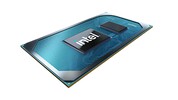Intel Core i3-1120G4 vs Intel Core i3-1115G4
Intel Core i3-1120G4
► remove from comparison
The Intel Core i3-1120G4 is a power-efficient quad-core SoC for laptops and Ultrabooks based on the Tiger Lake-U generation (UP4) that was introduced in September 2020. It integrates four Willow Cove processor cores (8 threads thanks to Hyper-Threading). Each core can clock from 1.1 GHz (base speed) to 3.5 GHz (1 core boost). All cores at once can clock at up to 3 GHz.
Another novelty is the integrated Xe graphics adapter based on the completely new Gen 12 architecture. The i3 integrates the low end UHD Graphics G4 with 48 of the 96 EUs enabled and a clock speed of 400 - 1100 MHz. The GPU and CPU can together use the 8 MB of L3 cache.
Furthermore, Tiger Lake SoCs add PCIe 4 support (4 lanes), AI hardware acceleration, and the partial integration of Thunderbolt 4 / USB 4 and Wi-Fi 6 in the chip.
Performance
While we have not tested a single system built around the 1120G4 as of August 2023, it's fair to expect the chip to be about half as fast as the Core i5-1125G4 (Tiger Lake, 4 cores, 8 threads, up to 3.7 GHz), as far as multi-thread benchmarks are concerned. The 1120G4's low TDP target is slated to limit the chip's real-world Boost clock speeds significantly leading to underwhelming performance and high DPC latencies.
Power consumption
This Core i3 has a default TDP of 7 W to 15 W, the expectation being that laptop manufacturers will go for a higher value in exchange for higher performance. The CPU is built with Intel's third-gen 10 nm process marketed as SuperFin for decent, as of late 2022, energy efficiency.
Intel Core i3-1115G4
► remove from comparison
The Intel Core i3-1115G4 is a dual-core SoC for laptops and Ultrabooks based on the Tiger Lake-U generation (UP3) that was launched in September 2020. It integrates two Willow Cove processor cores (4 threads thanks to HyperThreading). Each core can clock from 3 GHz (base speed) to 4.1 GHz (single- and dual-core boost). The faster Core i5 and i7 models offer more cores and are therefore significantly faster.
Another novelty is the integrated Xe graphics card based on the completely new Gen 12 architecture. In the i3-1115G4 Intel is naming the GPU UHD Graphics and offers only 48 of the 96 EUs clocked at 400 - 1250 MHz. GPU and CPU can together use the 6 MB of L3 cache.
Furthermore, Tiger Lake SoCs add PCIe 4 support (four lanes), AI hardware acceleration, and the partial integration of Thunderbolt 4 / USB 4 and WiFi 6 in the chip.
The chip is produced on the second-gen 10 nm Intel SuperFin process that should be comparable to the 7 nm TSMC process (e.g. Ryzen 4000 series).
Performance
Multi-thread peformance is most comparable to what the Intel Core i5-8250U and the AMD Ryzen 5 3450U deliver. This makes the i3 a more than decent option for day-to-day tasks; that said, any workload of the more taxing kind (such as exporting a high-bitrate, hour long UHD video) will be enough to bring the i3 to its knees.
Thanks to its decent cooling solution and a long-term CPU power limit of 25 W, the ThinkPad L15 G2-20X4S0KU00 is one of the fastest laptops powered by the 1115G4 we know of. It can be more than 20% faster in CPU-bound workloads than the slowest system featuring the same chip in our database, as of August 2023.
Power consumption
This Core i3 series chip has a default TDP of 12 W to 28 W, the expectation being that laptop makers will go for a higher value in exchange for higher performance. Either way, that's a tad too high to allow for passively cooled laptops, tablets, mini-PCs.
The Core i3-1115G4 is built with Intel's third-gen 10 nm process marketed as SuperFin for decent, as of mid 2022, energy efficiency.
| Model | Intel Core i3-1120G4 | Intel Core i3-1115G4 | ||||||||||||||||||||||||||||||||||||||||||||||||||||||||
| Codename | Tiger Lake-UP4 | Tiger Lake-UP3 | ||||||||||||||||||||||||||||||||||||||||||||||||||||||||
| Series | Intel Tiger Lake | Intel Tiger Lake | ||||||||||||||||||||||||||||||||||||||||||||||||||||||||
| Series: Tiger Lake Tiger Lake-UP3 |
|
| ||||||||||||||||||||||||||||||||||||||||||||||||||||||||
| Clock | 1500 - 3500 MHz | 3000 - 4100 MHz | ||||||||||||||||||||||||||||||||||||||||||||||||||||||||
| L1 Cache | 320 KB | 160 KB | ||||||||||||||||||||||||||||||||||||||||||||||||||||||||
| L2 Cache | 5 MB | 2.5 MB | ||||||||||||||||||||||||||||||||||||||||||||||||||||||||
| L3 Cache | 8 MB | 6 MB | ||||||||||||||||||||||||||||||||||||||||||||||||||||||||
| Cores / Threads | 4 / 8 | 2 / 4 | ||||||||||||||||||||||||||||||||||||||||||||||||||||||||
| TDP | 15 Watt | 28 Watt | ||||||||||||||||||||||||||||||||||||||||||||||||||||||||
| Technology | 10 nm | 10 nm | ||||||||||||||||||||||||||||||||||||||||||||||||||||||||
| max. Temp. | 100 °C | 100 °C | ||||||||||||||||||||||||||||||||||||||||||||||||||||||||
| Socket | BGA1598 | BGA1449 | ||||||||||||||||||||||||||||||||||||||||||||||||||||||||
| Features | LPDDR4x-4266 RAM, PCIe 4, 2 GT/s bus, DL Boost, GNA, MMX, SSE, SSE2, SSE3, SSSE3, SSE4.1, SSE4.2, AVX, AVX2, AVX-512, BMI2, ABM, FMA, ADX, SMEP, SMAP, EIST, TM1, TM2, Hyper-Threading, Turbo, SST, AES-NI, RDRAND, RDSEED, SHA | DDR4-3200/LPDDR4x-3733 RAM, PCIe 4, 4 GT/s bus, DL Boost, GNA, MMX, SSE, SSE2, SSE3, SSSE3, SSE4.1, SSE4.2, AVX, AVX2, AVX-512, BMI2, ABM, FMA, ADX, VMX, SMEP, SMAP, EIST, TM1, TM2, HT, Turbo, SST, AES-NI, RDRAND, RDSEED, SHA | ||||||||||||||||||||||||||||||||||||||||||||||||||||||||
| iGPU | Intel UHD Graphics Xe G4 48EUs (400 - 1100 MHz) | Intel UHD Graphics Xe G4 48EUs (400 - 1250 MHz) | ||||||||||||||||||||||||||||||||||||||||||||||||||||||||
| Architecture | x86 | x86 | ||||||||||||||||||||||||||||||||||||||||||||||||||||||||
| Announced | ||||||||||||||||||||||||||||||||||||||||||||||||||||||||||
| Manufacturer | ark.intel.com | ark.intel.com |
Benchmarks
Average Benchmarks Intel Core i3-1115G4 → 0% n=0
* Smaller numbers mean a higher performance
1 This benchmark is not used for the average calculation













